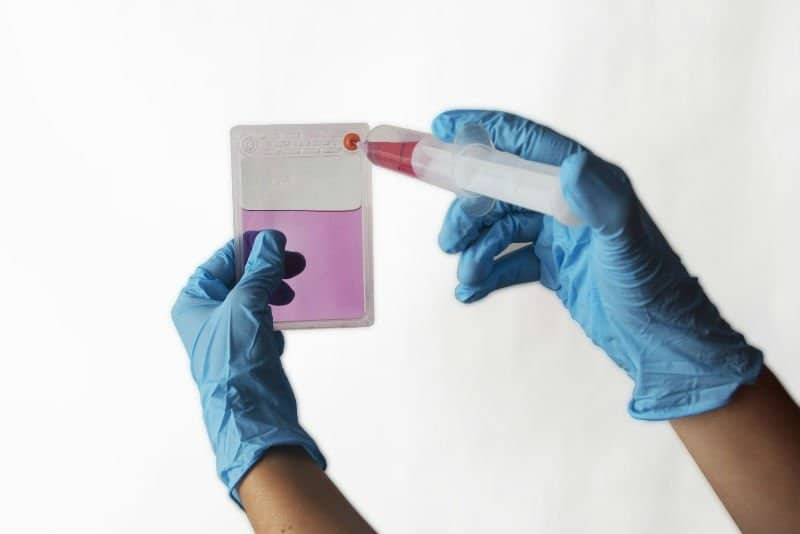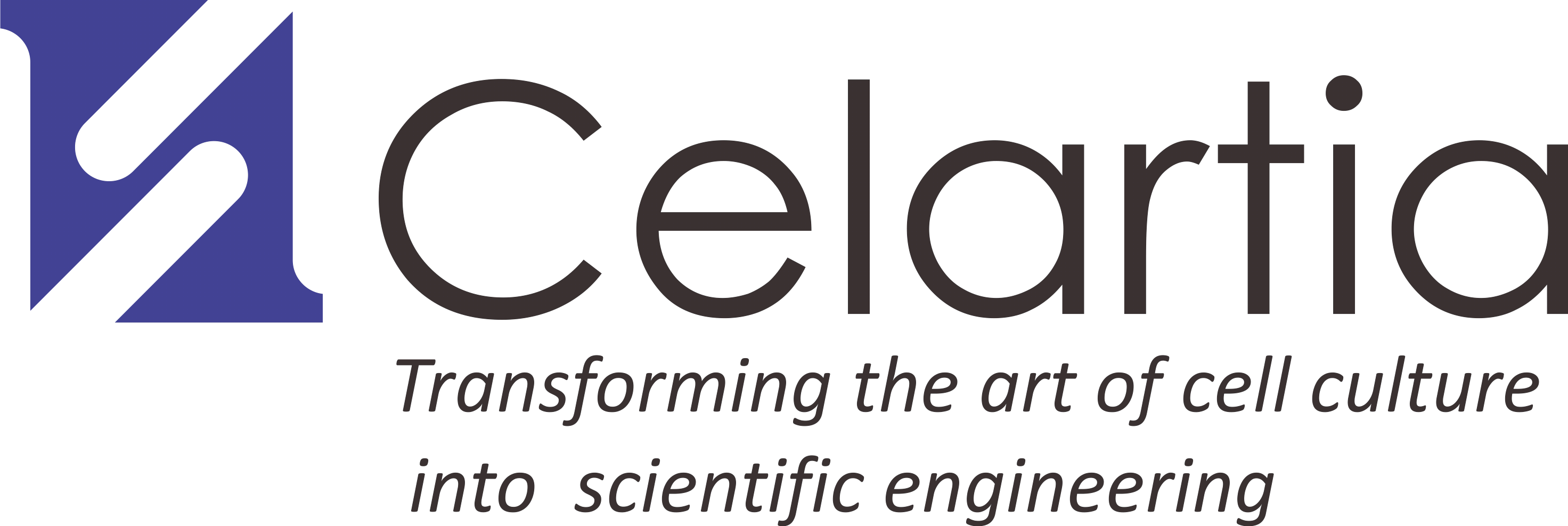Background
When researchers first learn that the Petaka G3™ can be used for live cell storage and shipping with high viability for 7-10 days, they often have questions about preparing the cells for room temperature pausing and about the minimum incubation time prior to storage conditions for shipping cells. These are important considerations. More than ten years of in-house study has led us to define many of the ideal conditions for the room temperature preservation of mammalian cells in Petaka.
We recommend to grow cells to at least 75% confluence over one or two days at 37°C. This allows for a reduction in pericellular oxygen from ~150mmHg pO2 down to 15-30mmHg pO2 and the pH to drop slightly to around 7.0, (a yellow-orange color) which supports cell pausing. It is also best to maintain the Petaka with around 24ml of medium to minimize the internal air volume. This combination of high cellular confluence, low physiologic dissolved oxygen, high medium volume, and slightly reduced pH has been shown to provide the ideal environment to support ambient temperature cell pausing. We have preserved dozens of cell types this way for weeks at a time, with excellent viability and recoveries.
Many times, however, researchers have unique experimental constraints. For example, some projects start with only 2 or 3 million cells which cannot be culture expanded prior to shipping. In these cases, the most common questions have been:
1) what is the minimum starting cell count?
2) how long should one incubate to achieve a sufficiently low pO2 prior to storage and shipping?
To better answer these questions, we ran an experiment with a low starting cell count and varying incubation times prior to ambient temperature pausing to determine a minimum incubation time for optimal results. Based on the equilibrium kinetics of the Petaka’s gas diffusion system, we calculate the minimum starting count of around 3 million cells. Next, we considered how long to incubate prior to room temperature cell pausing and storage. During initial incubation, actively growing cells drive the pericellular dissolved oxygen towards a point of equilibrium to low physiologic levels. From experience, we know that cultures with low starting cell counts (3MM) will typically achieve this equilibrium in 12-24 hours. Therefore, we predicted that incubation times between 12-24 hours will allow the cultures to achieve the low dissolved oxygen levels ideal to maintain cells for one week at ambient temperatures.
Methods
We seeded 15 Petaka with ~3MM (40,000 cells/cm2) adenocarcinoma cells (Coriell AG-13904 (NOU-1)), with atmosphere-saturated DMEM medium (10% FBS, 1%P/S), with high glucose and glutamine. Cells were allowed to attach over several hours and then the culture medium in all 15 Petaka were replaced with fresh, oxygen-saturated medium. Immediately, 3 Petaka were removed to a dark cabinet and placed horizontally in the Petaka stands to assume room temperature; these were marked time 0. Three additional Petakas were likewise removed to ambient temperature after 6-hours, 12-hours, 24-hours, and 36-hours of incubation. All paused cell samples were maintained horizontally in a dark cabinet at room temperature (~23 degrees C) for seven days, +/- 4 hours. We chose seven days of storage because it is short enough time where we still observe high viability (>90%), but it is long enough to provide a meaningful pause in a critical bio-process or to ship critical samples worldwide. After seven days of cell pausing, the maintenance medium was removed along with the floating cells by aspiration and the attached cells were removed with trypsin. Live/dead cell count were made using the trypan blue method for both the suspended and attached cell fractions. It is common to observe a significant percentage of detached cells during extended pausing. For adherent cells in routine culture this typically indicates cell death, but this is not the case during cell pausing because quiescent cells can release from the growth surface while resistant to anoikis effects.
Results
We observed that the majority of cells remained attached after one week of cell preservation (55-67%) in all samples except for the 0-hour treatment period (42% attached). There is no significant difference among the other time periods (6-36 hours), suggesting that after 6-hours incubation the effect on attachment is maximized for this cell type.
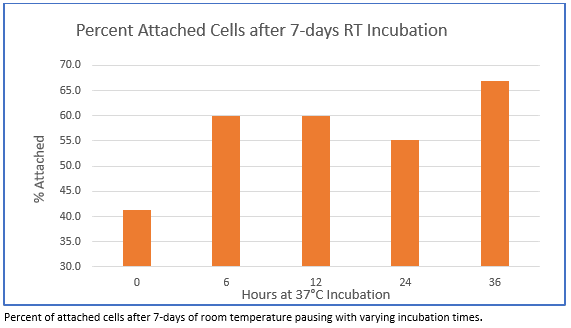
The viability test revealed maximum improvement after 12-hours of incubation prior to cell pausing. There was no significant difference in viability among 12-, 24- and 36-hour incubation, (91-93%). We were surprised to find such a high viability (84%) even with 0-hours of 37°C incubation time.
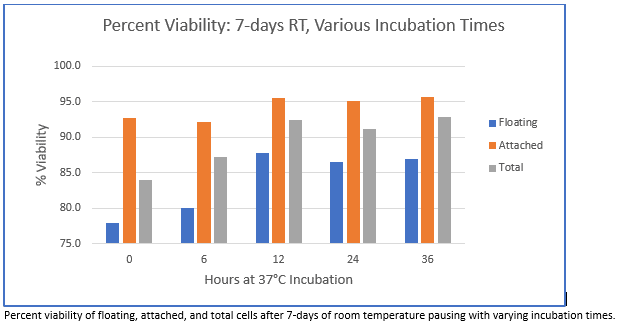
For this test, using a minimum number of 3MM cells, the data suggest that to achieve maximum cell viability for one-week of ambient temperature storage, a minimum of 12-hours incubation will suffice, with longer incubation periods of 24- and 36-hours providing little or no benefit but resulting in no loss of viability either.
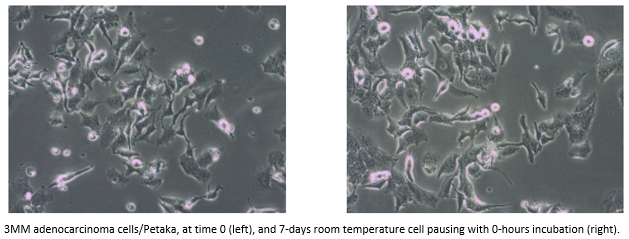
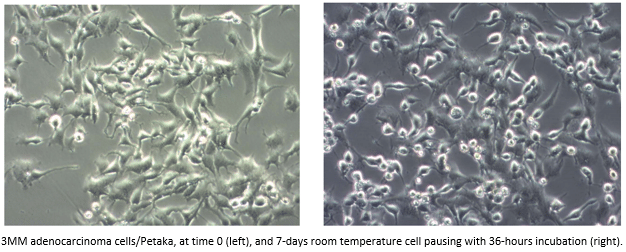
Conclusions and Recommendations
Ambient temperature cell pausing is a fantastic new tool for temporary cell storage or live cell shipping that eliminates the need for cryopreservation. However, harnessing this phenomenon is not possible in standard cell culture ware. For temporary cell storage up to one week, it is recommended to seed the Petaka LOT or FLAT with at least 3MM cells and to incubate at 37°C for a minimum of 12-hours. Using this protocol, the percent of attached cells and the total cell viability were optimized to support up to one week of temporary, live cell storage or live cell shipping. It is important to note that after one week most floating cells are still viable, and thus should be allowed to re-attach with re-incubation at 37°C upon receipt.
In cases with a starting cell count lower than 3MM, the user is encouraged to repeat this type of test to validate the acceptable incubation and storage times and for their particular cell system. When using more than 3MM starting cells, we would expect the minimum incubation time to be shortened to somewhere less than 12-hours, but Petaka users around the world have found that an overnight incubation is both convenient and provides reliable results for a variety of cell types.
